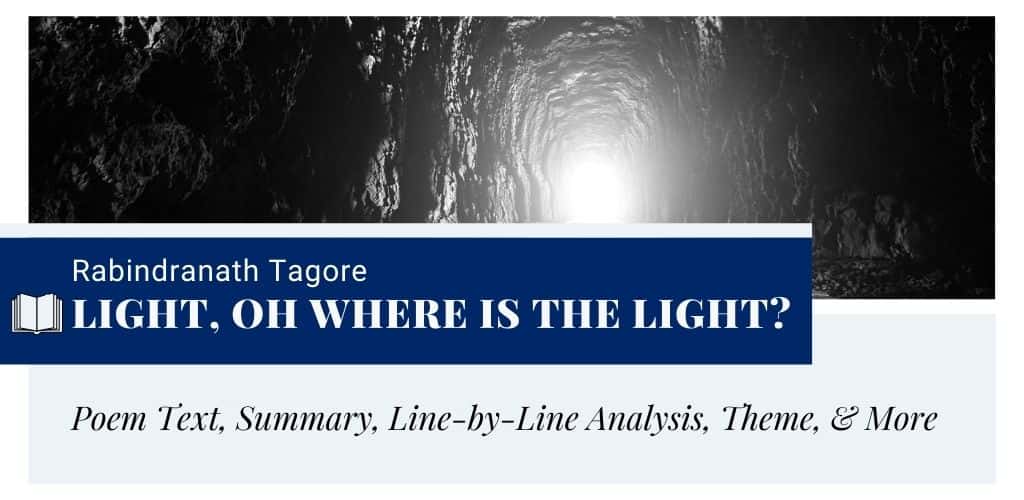Light, oh where is the light? by Rabindranath Tagore
“Light, oh where is the light?” appears as verse 27 (XXVII) in Rabindranath Tagore’s Nobel Prize-winning collection, Gitanjali. This poem is about Tagore’s yearning for the divine light. Whenever a soul is in seek of the slightest ray of spirituality, Gitanjali or Song Offerings is born. It is not only the name of a poet’s masterpiece but it is a way of seeking the unseen. Through this heart-to-heart verse, Tagore first portrays himself as a wanderer roaming on the path of spiritual awakening. Then he realizes that kindling the lamp of love with his own life is the best way of visualizing the divine aura.
- Read the full text of “Light, oh where is the light?” below:
Light, oh where is the light? by Rabindranath Tagore Light, oh where is the light? Kindle it with the burning fire of desire! There is the lamp but never a flicker of a flame,—is such thy fate, my heart! Ah, death were better by far for thee! Misery knocks at thy door, and her message is that thy lord is wakeful, and he calls thee to the love-tryst through the darkness of night The sky is overcast with clouds and the rain is ceaseless. I know not what this is that stirs in me,—I know not its meaning. A moment's flash of lightning drags down a deeper gloom on my sight, and my heart gropes for the path to where the music of the night calls me. Light, oh where is the light! Kindle it with the burning fire of desire! It thunders and the wind rushes screaming through the void. The night is black as a black stone. Let not the hours pass by in the dark. Kindle the lamp of love with thy life. - from Song Offerings (1913)

Summary
Tagore’s “Light, oh where is the light?” begins with a reference to his poetic persona who is in search of the divine light. His weary eyes badly need a glance of the light that would help him in spiritual awakening. He can visualize the lamp, not the flicker of the light. In this condition, his heart tells him that death is way better than hopeless wandering. Misery knocks at his mind’s door and tells him that the lord is ever-wakeful. He is waiting for him in the darkness. No matter if his sky is overcast with dark clouds or it is raining, he gropes for the path to find the source of the nocturnal music. In the end, he has a revelation. According to him, it is better to kindle the “lamp of love” than letting the gloomy hours pass by.
Structure & Form
Verse 27 from Gitanjali is a prose poem. It consists of 6 prosaic lines. Tagore does not separate the ideas adhering to the conventional poetic structure. He rather wishes to present his thoughts as it surfaces in his mind. Such a structure of lines portrays the mental state of the speaker. His mind is weary of the long journey to find the divine light. Hence, the thoughts do not come in a rhythmic manner. Besides, this piece is addressed to the poet’s heart. He distances himself from his persona and directs him to do what is needed rather than sitting idly in the darkness of his life.
Poetic Devices & Figurative Language
Tagore makes use of a number of poetic devices in “Light, oh where is the light?”. These devices collectively make the poetic yearning for the divine light more appealing to readers.
- Rhetorical Question: The poem begins with a rhetorical question: “Light, oh where is the light?” This line sets the tone and mood of the overall work.
- Rhetorical Exclamation: The first two lines present a series of exclamations. By using this device, Tagore expresses his grief and hopelessness.
- Personification: Tagore personifies the inanimate ideas such as “Misery”, “flash of lightning”, “heart”, “music of the night”, etc.
- Metaphor: In this poem, the “light” is a metaphorical reference to spiritual awakening or the divine light that fulfills one seeker. Tagore also uses some other metaphors in the text. For example, “burning fire of desire” contains an implicit comparison between “desire” and “fire”.
- Synecdoche: By referring to his “heart”, the poet is hinting at himself as a whole.
- Alliteration: It occurs in “fire of desire”, “flicker of a flame”, “better by“, “far for”, “thy door”, etc.
Themes
The main theme of this verse is a soul’s yearning for the divine light. Tagore also taps on the themes of spirituality, pessimism, and love in this poem. His main idea revolves around the spiritual yearning of his soul. Firstly, he portrays his mental state in a somber and depressing tone. His mind is so engrossed in the gloom of hopelessness that he even wishes to die. As he progresses further on the path of spirituality, he finds several challenges. Sometimes, he can see a spark. For the rest of his journey, he can see nothing but darkness. At last, he realizes that he has unmindfully wasted his precious time. So, he wishes to kindle the flame of love within his heart by giving his yearning a poetic manifestation.
Line-by-Line Analysis & Critical Appreciation
Lines 1-2
Light, oh where is the light? Kindle it with the burning fire of desire!
There is the lamp but never a flicker of a flame,—is such thy fate, my heart! Ah, death were better by far for thee!
Tagore’s verse 27 begins with a thought-provoking question. His poetic persona asks for the source of the divine light that guided seekers before. He is also a seeker. For the most part of his journey, he had faced only failures. He cannot find the “light” which is a symbol of divinity.
The following part of the first line contains a rhetorical exclamation. Tagore tells his persona to kindle his lamp with the “fire of desire”. The “fire of desire” stands for the burning passion in one speaker’s heart for the divine light. Tagore is of the view that only by increasing the intensity of his devotion, he can see the light.
In the following line, the poet refers to a “lamp”. It is a symbol of the soul. According to him, the lamp is not lit. Only a “flicker” of the divine flame (or the “fire of desire”) can enlighten his soul. Furthermore, he rebukes his heart in a lowly tone by saying that it is destined to live in darkness. Here, the poet is actually rebuking himself. He even says that the darkness of death is far better for him than the “light”.
Lines 3-4
Misery knocks at thy door, and her message is that thy lord is wakeful, and he calls thee to the love-tryst through the darkness of night
The sky is overcast with clouds and the rain is ceaseless. I know not what this is that stirs in me,—I know not its meaning.
In the third line, Tagore uses personification in order to infuse life into the abstract concept of “misery”. He portrays “misery” as a kind, optimistic lady who guides him amidst the darkness. She knocks at his mind’s door and tells him that his lord is ever-wakeful.
The idea of “misery” conveying a message of optimism is paradoxical. Does it make sense? Indeed, in extreme distress, there comes misery, with her kind, mellow voice of optimism. It is misery that inspires one to do better by igniting the spirit. So, misery is part of spirituality. It helps a seeker realize the importance of divine light.
In the case of Tagore, misery acts as a messenger of the lord. She tells him that God calls him to the divine tryst through the metaphorical “darkness of night”. The quoted phrase is a symbol of pessimism and confusion.
Furthermore, Tagore describes his symbolic sky of mind being covered with clouds. The rain, a metaphorical reference to sorrowfulness, is ceaseless in his life. However, the poet can still fill the yearning inside him. It “stirs” even if there is darkness around him. He does not know its meaning yet he knows the thing, stirring in him, has something to say. It is a reference to the spiritual impulse that motivates him to continue the journey.
Line 5
A moment’s flash of lightning drags down a deeper gloom on my sight, and my heart gropes for the path to where the music of the night calls me.
In the fifth line of “Light, oh where is the light?”, Tagore says that in the complete darkness, he has suddenly seen a “moment’s flash of lightning”. It is a referral to a spark of the divine that seekers often witness. The slightest spark is so intense that it blinds his eyes. In this line, Tagore uses alliteration of the hard “d” sound (“drags down a deeper”) in order to reflect the effect of the light on his mind.
After seeing the spark, he cannot even find his way to divinity. His heart helplessly gropes for the path to find the source of the “music” coming from the bleakest soul of night. Here, Tagore metaphorically compares the divine existence to a “music” that entices his soul.
Line 6
Light, oh where is the light! Kindle it with the burning fire of desire! It thunders and the wind rushes screaming through the void. The night is black as a black stone. Let not the hours pass by in the dark. Kindle the lamp of love with thy life.
The last line is the longest and the most important one. It contains the revelation of the poetic persona. This line begins with a refrain of the first line meant for the sake of emphasis.
Tagore uses the imagery of a storm to portray his mental state. Previously, his mind was in an idle state. As he starts moving, there appears a storm in his path. It rushes through the void of his mind. Here, the poet personifies the gusting wind, an inanimate object, and invests it with the idea of screaming.
He uses a simile in the line “The night is black as a black stone”. Here, the impenetrable blackness of the night is compared to a “black stone”. Besides, the word “stone” symbolizes the idea of harshness. It means the effect of the night is harsh on his mind.
Finally, the persona realizes that sitting idly in the dark is by no means going to help him. In order to be closer to his lord or the divine soul, he needs to kindle the “lamp of love” with his own life. Through burning passion and unconditional love for the divine spirit, one can attain spiritual awakening.
Historical Context
The verse ”Light, oh where is the light?” appears as the 27th verse of Rabindranath Tagore’s masterpiece Gitanjali. Originally, it was published on August 14, 1910. Tagore rendered the collection of poems into English. It was published in November 1912 as Song Offerings by the Indian Society in London. Tagore composed the Bengali verses between 1904 and 1910. Prior to his visit to England in 1912, he started translating the poems. The collection was well-received there. In 1913, he became the first Indian to receive the Nobel Prize for Literature, for the Song Offerings. It is part of the UNESCO Collection of Representative Works.
Questions & Answers
In this poem, “light” is a symbol of the divine existence a spiritual seeker craves for. The light penetrates through darkness and helps one clearly visualize his goal amidst the darkness of ignorance.
In ”Light, oh where is the light?”, Tagore talks about his yearning for the divine light. Throughout this poem, he describes his mental state. Finally, he realizes that it is better to kindle light by himself rather than sitting idly in the darkness.
The “lamp of love” is a metaphor. It is a reference to one seeker’s love for the almighty. According to Tagore, this devotion or love acts as a lamp and enlightens his path to spiritual awakening.
The source of light lies within oneself. According to Tagore, it is up to a seeker whether he lights the lamp or not.
The central theme of Gitanjali or Song Offerings is devotion to the divine. Within the body of this work, he sings his verses to the lord. He tries to help those who are in search of the divine light through this collection.
Explore More Rabindranath Tagore Poems
External Resources
- Full Text of Gitanjali — Refer to the text of all the 103 poems published in the collection Song Offerings.
- Presentation Speech by the Nobel Committee — Read the presentation speech for the 1913 Nobel Prize-winning collection of poems, Gitanjali: Song Offerings by Tagore.
- Biography of Rabindranath Tagore — Read the poet’s biography and his works.
- Rabindranath Tagore & His Poems — Learn more about the poet and read some of his best-known poems in English.



